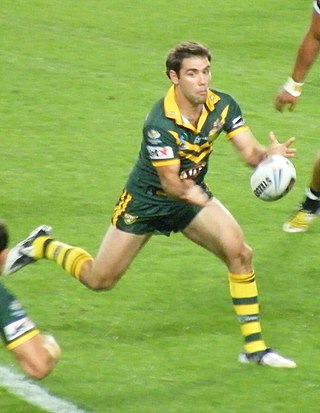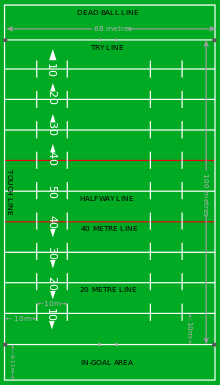
Canadian football, or simply football, is a sport in Canada in which two teams of 12 players each compete on a field 110 yards (101 m) long and 65 yards (59 m) wide, attempting to advance a pointed oval-shaped ball into the opposing team's end zone.

In sport, a goal may refer to either an instance of scoring, or to the physical structure or area where an attacking team must send the ball or puck in order to score points. The structure of a goal varies from sport to sport, and one is placed at or near each end of the playing field for each team to defend. Sports which feature goal scoring are also commonly known as invasion games.

A try is a way of scoring points in rugby union and rugby league football. A try is scored by grounding the ball in the opposition's in-goal area. Rugby union and league differ slightly in defining "grounding the ball" and the "in-goal" area. In rugby union a try is worth 5 points, and in rugby league a try is worth 4 points.
In rugby football, the penalty is the main disciplinary sanction available to the referee to penalise players who commit deliberate infringements. The team who did not commit the infringement are given possession of the ball and may either kick it towards touch, attempt a place kick at goal, or tap the ball with their foot and run it. It is also sometimes used as shorthand for penalty goal.

A football pitch or soccer field is the playing surface for the game of association football. Its dimensions and markings are defined by Law 1 of the Laws of the Game, "The Field of Play". The pitch is typically made of natural turf or artificial turf, although amateur and recreational teams often play on dirt fields. Artificial surfaces are allowed only to be green in colour.

Like most forms of modern football, rugby league football is played outdoors on a rectangular grass field with goals at each end that are attacked and defended by two opposing teams. The rules of rugby league have changed significantly over the decades since rugby football split into the league and union codes. This article details the modern form of the game and how it is generally played today, although rules do vary slightly between specific competitions.

A comparison of American football and rugby union is possible because of the games' shared origins, despite their dissimilarities.
A comparison between American football and rugby league is possible because of their shared origins and similar game concepts. Rugby league is arguably the most similar sport to American football after Canadian football: both sports involve the concept of a limited number of downs/tackles and scoring touchdowns/tries takes clear precedence over goal-kicking.

A drop goal, field goal, or dropped goal is a method of scoring points in rugby union and rugby league and also, rarely, in American football and Canadian football. A drop goal is scored by drop kicking the ball over the crossbar and between the posts of the goal posts. After the kick, the ball must not touch the ground before it goes over and through, although it may touch the crossbar, the uprights or an opponent. A drop goal in rugby union is worth three points, and in rugby league a drop goal is usually worth one point.

Rugby union is a contact sport that consists of two teams of fifteen players. The objective is to obtain more points than the opposition through scoring tries or kicking goals over eighty minutes of playing time. The play is started with one team drop-kicking the ball from the halfway line towards the opposition. The rugby ball can be moved up the field by either carrying it or kicking it. However, when passing the ball it can only be thrown laterally or backward. The opposition can stop players moving up the field by tackling them. Only players carrying the ball can be tackled and once a tackle is completed the opposition can compete for the ball. Play continues until a try is scored, the ball crosses the side line or dead-ball line, or an infringement occurs. After a team scores points, the non-scoring team restarts the game at the halfway with a drop kick toward the opposition. The team with the most points at the end wins the game.
This is a general glossary of the terminology used in the sport of rugby union. Where words in a sentence are also defined elsewhere in this article, they appear in italics.
Rugby league football has accrued considerable jargon to describe aspects of the game. Many terms originate in the Laws of the Game. Some aspects of the game have more than one term referring to them. Different terms have become popularly used to describe an aspect of the game in different places, with notable differences between the Northern and Southern Hemispheres.
A comparison of Canadian football and rugby union is possible because of the games' shared origins, despite their dissimilarities.

Rugby league match officials are responsible for fairly enforcing the Laws of the Game from a neutral point of view during a match of rugby league football and imposing penalties for deliberate breaches of these Laws. The most senior match official is the referee. They may be assisted by a range of other officials depending on the level and rules of the competition.
A comparison of Canadian football and rugby league football can be made because of their shared origins, resulting in similarities and shared concepts in terms of scoring and advancing the ball. Aside from American football, rugby league is the sport most similar to Canadian football. Both sports involve the concept of a limited number of 'downs'/'tackles', and in both sports scoring 'touchdowns'/'tries' takes a clear precedence over goal-kicking.
In rugby league football, the Laws of the Game are the rules governing how the sport is played. The Laws are the responsibility of the Rugby League International Federation, and cover the play, officiating, equipment and procedures of the game.

The laws of Rugby Union are defined by World Rugby and dictate how the game should be played. They are enforced by a referee, generally with the help of two assistant referees.

Comparison of association football (football/soccer) and rugby union is possible because of the games' similarities and shared origins.

Futsal began in the 1930s in South America as a version of association football, taking elements of its parent game into an indoor format so players could still play during inclement weather. Over the years, both sports have developed, creating a situation where the two sports share common traits while also hosting various differences.












